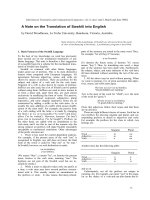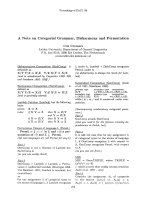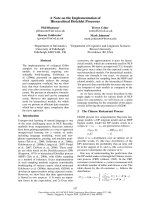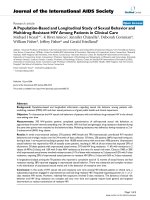Báo cáo hóa học: " A note on the Königs domain of compact composition operators on the Bloch space" doc
Bạn đang xem bản rút gọn của tài liệu. Xem và tải ngay bản đầy đủ của tài liệu tại đây (241.39 KB, 7 trang )
RESEARCH Open Access
A note on the Königs domain of compact
composition operators on the Bloch space
Matthew M Jones
Correspondence: m.m.jones@mdx.
ac.uk
Department of Mathematics,
Middlesex University, The
Burroughs, London, NW4 4BT, UK
Abstract
Let
D
be the unit disk in the complex plane. We define
B
0
to be the little Bloch
space of functions f analytic in
D
which satisfy lim
|z|®1
(1 - |z|
2
)|f’(z)| = 0. If
ϕ
: D → D
is analytic then the composition operator C
: f ↦ f ∘ is a continuous
operator that maps
B
0
into itself. In this paper, we show that the compactness of C
, as an operator on
B
0
, can be modelled geometrically by its principal eigenfunction.
In particular, under certain necessary conditions, we relate the compactness of C
to
the geometry of
= σ
(
D
)
, where s satisfies Schöder’s functional equation s ∘ =
’(0)s.
2000 Mathematics Subject Classification: Primary 30D05; 47B33 Secondary 30D45.
1 Introduction
Let
D =
{
z ∈
C
:
|
z
|
< 1
}
be the unit disk in the complex plane and
T
its boundary. We
define the Bloch space
B
to be the Banach space of functions, f, analytic in
D
with
||f ||
B
= |f (0)| +sup
z
∈
D
(1 −|z|
2
)|f
(z)| < ∞
.
This space has many important applications in complex function theory, see [1] for
an overview of many of them. We denote by
B
0
the little Bloch space of functions in
B
that satisfy lim
|z|®1
(1 - |z|
2
)|f ’(z)| = 0. This space coincides with the closure of the
polynomials in
B
.
Suppose now that
ϕ
:
D
→
D
is analytic, then we may define the operator, C
, acting
on
B
0
as f ↦ f ∘ . It was shown in [2] that every such operator maps
B
0
continuously
into itself. Moreover, it was proved that C
is compact on
B
0
if and only if satisfies
lim
|z |→1
1 −|z|
2
1 −|ϕ
(
z
)
|
2
|ϕ
(z)| =0
.
(1)
Recall that the hyperbolic geometry on
D
is defined by the distance
disk(z, w)=inf
λ
D
(η) |dη
|
where the infimum is taken over all sufficiently smooth arcs that have endpoints z
and w.
Jones Journal of Inequalities and Applications 2011, 2011:31
/>© 2011 Jones; licensee Springer. This is an Open Access article distributed under the terms of the Creative Commons Attribution
License (http://creativeco mmons.org/licenses/by/2.0), which permits unrestricted use, distribution, and reproduction in any medium,
provided the original work is properly cited.
Here,
λ
D
(
η
)
=
(
1 −|η|
2
)
−
1
is the Poincaré density of
D
. The hyperbolic derivative of
is given by ’(z)/(1 - |(z)|
2
) and functions that satisfy (1) are called little hyperbolic
Bloch functions or written
ϕ ∈ B
H
0
.
The Schröder functional equation is the equation
σ ◦ ϕ =
γ
σ
.
(2)
Note that this is just the eigenfu nction equation for C
.Kœnig s’ theorem states that
if has fixed point at the origin then (2) has a unique solution for g = ’(0) which we
call the Kœnigs function and denot e by s from here on. In the study of the geometric
properties of in relation to the operator theoretic properties of C
, it has become
evident that the Kœnigs function is much more fruitful to study than itself. In parti-
cular, see [3] for a discussion of the Kœnigs function in relation to compact composi-
tion operators on the Hardy spaces.
If we let
= σ
(
D
)
be the Kœnigs domain of , then (2) may be interpreted as imply-
ing that the action of on
D
is equivalent to multiplication by g on Ω. It is due to this
that the pair (Ω, g ) is often called the geometric model for .
In this paper, we study the geometry of Ω when
ϕ ∈ B
H
0
. In order to do this, we will
use the hyperbolic geometry of Ω.If
f
: D →
is a universal covering map and Ω is a
hyperbolic domain in ℂ, then the Poincaré density on Ω is derived from the equation
λ
(
f
(
z
))
|f
(
z
)
| = λ
D
(
z
),
which is independent of the choice of f. Since this equation, in terms of differentials,
is
λ
(
w
)
|dw| = λ
D
(
z
)
|dz
|
(for w = f (z)), we see that the hyperbolic distance on
D
defined above carries over to a hyperbolic distance on Ω. For a more thorough treat-
ment of the hyperbolic metric, see [4].
In [5], the Königs domain of a compact composition operator on the Hardy space
was studied and the following result was proved.
Theorem A. Let be a univalent self-map of
D
with a fixed point in
D
. Suppose that
for some positive integer n
0
there are at most finitely many points of
T
at which
ϕ
n
0
has
an angular derivative. Then the following are equivalent .
1. Some power of C
is compact on the Hardy space H
2
;
2. s lies in H
p
for every p <∞;
3.
= σ
(
D
)
does not contain a twisted sector.
Here, Ω is said to contain a twisted sector if there is an unbounded curve Γ Î Ω
with
δ
(
w
)
≥ ε|w
|
for some ε > 0 and all w Î Γ, where δ
Ω
is the distance from w to the boundary of Ω
as defined below. The purpose of this paper is to provide a similar result to this in the
context of the Bloch space.
2 Simply connected domains
Throughout this section, we assume that Ω is an unbounded simply connected domain
in ℂ with 0 Î Ω. As in the previ ous section, s represents the Riemann m apping of
D
Jones Journal of Inequalities and Applications 2011, 2011:31
/>Page 2 of 7
onto Ω with s(0) = 0 and s’(0) > 0. We will also define via the Schröder functional
equation. Throughout we let
δ
(w)=inf
ζ
∈
|w − ζ |
,
so that δ
Ω
(w) is the Euclidean distance from w to the boundary of Ω.
Theorem 1. Let be a univalent function mapping
D
into
D
, (0) = 0. Suppose that
the closure of
ϕ
(
D
)
intersects
T
only at finitely many fixed points and is contained in a
Stolz angle of opening no greater than aπ there.
If |’(0)| > 16 tan(aπ/2) then the following are equivalent
1. C
is compact on
B
;
2.
lim
w
→∞
w
∈
γ
δ
(w)
δ
(γ w)
=
0
;
3. For every n >0,
σ
n
∈
B
0
.
Remark: It has recently been shown by Smith [6] that compactness of C
on
B
is
equivalent to compactness of C
on
B
0
, BMOA and VMOA when is univalent and so
in the above theorem, the first condition could read: C
is compact on
B
,
B
0
, BMOA
and VMOA Before proceeding, we prove the following lemma.
Lemma 1. Under the hypotheses of the theorem, w and gwtendtothesameprime
end at ∞ , and ∂gΩ ⊂ Ω.
Proof. The first asser tion follows from the fact that the closure of
ϕ
(
D
)
touches
T
only at fixed points. Suppose now that the second assertion is false and there are dis-
tinct prime ends r
1
and r
2
with r
1
= gr
2
. Then under the boundary correspondence
given by s there are distinct points h,
ζ
∈ T
with
σ
(
η
)
= γσ
(
ζ
)
= σ
(
ϕ
(
ζ
)).
It follows that
ϕ
(
ζ
)
∈
T
and therefore ζ is a fixed point of .Hence,wehavethe
contradiction r
1
= r
2
. □
Proof. We first prove that 1 is equivalent to 2.
By the results of Madigan and Matheson [2], and Smith [6] cited above C
is com-
pact on
B
if and only if
lim
|z|→1
1 −|z|
2
1 −|ϕ
(
z
)
|
2
|ϕ
(z)| =0
.
However, by Schröder’s equation
1 −|z|
2
1 −|ϕ(z)|
2
|ϕ
(z)| =
λ
D
(ϕ(z))
λ
D
(z)
|ϕ
(z)|
=
λ
(σ ◦ ϕ(z))
λ
(σ (z))
|σ
◦ ϕ(z)ϕ
(z)|
|σ
(z)|
= |γ |
λ
(γ w)
λ
(
w
)
Since Ω is simply connected, l
Ω
(w) ≍ 1/δ
Ω
(w)andsoC
is compact on
B
if and
only if
Jones Journal of Inequalities and Applications 2011, 2011:31
/>Page 3 of 7
lim
w
→∂
δ
(w)
δ
(
γ w
)
=0
.
(3)
Since gΩ ⊂ Ω, gw ® ∂Ω implies that w ® ∂Ω. Therefore, (3) holds if and only if
lim
γ w→∂
δ
(w)
δ
(
γ w
)
=0
.
By the Lemma, we see that gw ® ∂Ω means w ® ∞ and w Î gΩ,andwehave
shown that 1 and 2 are equivalent.
Suppose that 2 holds and let ε > 0 be given. Then we can find a R > 0 so that δ
Ω
(w)
<εδ
Ω
(g w)forall|w|>R , since there are only a finite number of prime ends at ∞.
Choose w Î Ω arbitrarily with modulus greater than R and let n satisfy |g|
-n
R <|w| ≤
|g |
-n -1
R.
Then we have that δ
Ω
(w) < ε
n
δ
Ω
(g
n
w) and hence
− log δ
(w)
log |w|
>
−n log ε − log δ
(γ
n
w)
−
(
n +1
)
log |γ | +logR
.
Now as w ® ∞ in gΩ, g
n
w lies in a closed set properly contained in Ω and therefore
δ
Ω
(g
n
w) is bounded below by a constant independent of w. We thus have that
lim
w→
inf
∞
− log δ
(w)
lo
g
|w|
>
− log ε
− lo
g
|γ |
and since ε was arbitrary, the left-hand side of the above inequality must tend to ∞.
Hence, we have shown that lim
w®∞
|w|
b
δ
Ω
(w) = 0 for every b >0.
Now
σ
n
∈ B
0
may be interpreted geometrically as lim
w®∂Ω
n|w|
n-1
δ
Ω
(w)=0and
this follows from the above argument. Therefore, 2 implies 3.
To show that 3 implies 2, we need to show that if
lim
w
→∞
f (w) = lim
w→∞
− log δ
(w)
lo
g
|w|
=
∞
then 2 holds.
To complete the proof, we require the following lemma whose proof we merely
sketch.
Lemma 2. Under the hypotheses of the theorem,
lim sup
w→∞
δ
(w)
δ
(
γ w
)
≤ K < 1
.
Sketch of Proof. First note that
lim sup
|
w
|
→1
δ
(w)
δ
(γ w)
≤
16
|ϕ
(0)|
lim sup
|
z
|
→1
δ
ϕ(D)
(z)
δ
D
(z)
.
Now if
ϕ
(
D
)
lies in a non-tangential angle of opening aπ at ζ, then a short calcula-
tion shows that
lim sup
z→
ζ
δ
ϕ(D)
(z)
δ
D
(z)
≤ tan
απ
2
and the assertion follows. □
Jones Journal of Inequalities and Applications 2011, 2011:31
/>Page 4 of 7
Now with f defined above, we have
f (γ w) − f(w)=
− log δ
(γ w)
log |γ w|
−
− log δ
(w)
log |w|
∼
log δ
(w)/δ
(γ w)
lo
g
|w|
< 0
for large enough w. Hence,
δ
(w)
δ
(
γ w
)
=
|γ |
f (γ w)
|w|
f (w)−f (γ w)
≤|γ |
f (γ w)
→
0
as w ® ∞ and so 2 holds. □
It is of interest to consider the growth of s since condition 3 would imply that it has
very slow growth. The following corollary follows from 3 and the fact that functions in
B
0
grow at most of order log 1/(1 - |z|).
Corollary 1. Suppose that satisfies the hypotheses of the Theorem and that any of
the equivalent conditions holds, then for r =|z|.
log |σ (z)| = o
log log
1
1 − r
.
We also provid e the followin g restatement of the hypotheses of Theorem 1 to illus-
trate the main properties of the Königs domain.
Corollary 2. Let Ω be an unbounded domain in ℂ with gΩ ⊂ Ω and 0 Î Ω. Suppose
that has Ω only finitely many prime ends at ∞ and
lim sup
w→∞
δ
(w)
δ
(
γ w
)
< 1
.
In addition, suppose that ∂gΩ ⊂ Ω. If
σ
:
D →
, s(0) = 0, s’ (0) > 0, and is
defined by Schröder’s equation, then the following are equivalent.
1. C
is compact on
B
;
2.
lim
w
→∞
w
∈
γ
δ
(w)
δ
(γ w)
=
0
;
3. For every n >0,
σ
n
∈
B
0
.
The hypothesis on the boundary of Ω is vita l. If we do not assume that ∂gΩ ⊂ Ω,
then we deduce from the proof of the Theorem that
ϕ ∈ B
H
0
is equivalent to
lim
γ w→∂
δ
(w)
δ
(
γ w
)
=0
.
(4)
In this situation, the finite part of the boundary of Ω plays a complicated role in the
behaviour of . We conclude this section by constructing a domain that displays very
bad boundary properties. This answers a question of Madigan and Matheson in [2].
In [2] it was shown that if ∂(D) touches
T
=
∂D
in a cusp, then
ϕ ∈ B
H
0
. However, it
isnotsufficientthat∂(D) touches
T
at an angle greater that 0. The question was
raised of whether or not it is possible that
ϕ
(
D
)
∩
T
can be infinite.
Jones Journal of Inequalities and Applications 2011, 2011:31
/>Page 5 of 7
With the hypothesis that ∂gΩ ⊂ Ω the prime ends at ∞ correspond to points of
ϕ
(
D
)
that touch
T
. Therefore,
ϕ
(
D
)
∩
T
is at most countable. A natural question to
ask is whether or not
(
ϕ
(
D
)
∩ T
)
can ever be positive, where Λ represents linear
measure.
This example is well known in the setting of the unit disk, see [7, Corollary 5.3]. We
describe here the construction in terms of the Königs domain.
Theorem 2. There is a univalent function
ϕ ∈ B
H
0
such that
ϕ
(
D
)
∩ T = T
.
Proof. We construct the domai n Ω so that it satisfies (4). Let 0 <g <1begiven.We
will define a nested sequence
n
⊂
T
, n = 1, 2, so that
∂ = ∪
n≥1
re
iθ
: γ
−n
≤ r < ∞, θ ∈
n
,
(5)
where Θ
n
⊂ Θ
n+1
for all n = 1, 2,
First let N > 2 be chosen arbitrarily and let Θ
1
={2πk/N : k = 0, , N-1}.
Suppose now that Θ
n
has been defined, then let Θ
n+1
be such that Θ
n
⊂ Θ
n+1
and
whenever θ Î Θ
n
is isolated, we define a sequence θ
k
Î Θ
n+1
, k = 1, 2, , so that θ
k
®
θ as k ® ∞ and for each k there is a j so that θ - θ
k
= θ
j-θ
. Moreover, assume that
lim
k→∞
θ
k+1
−
θ
k
(
θ − θ
k
)
2
=0
.
(6)
In this way, we define the sequence of sets Θ
n
, n = 1, 2, We will, furthermore,
assume that for each
e
i
θ
∈ T
, there is a sequence θ
n
Î Θ
n
, n = 1, 2, , such that θ
n
®
θ.
We claim that this gives the desired domain Ω with boundary defined by (5).
To see this, let gw Î Ω be arbitrary, then by construction, we may find a ζ Î ∂Ω so
that δ
Ω
(gw)=|ζ - gw|. It is readily seen that for such ζ, there is an n so that ζ Î {re
iθ
:
r ≥ g
-n
} for some θ Î Θ
n
and moreover, θ is isolated in Θ
n
.
If we now consider w, we may find a sequenc e θ
k
® θ as k ® ∞ so that
{re
iθ
k
: r ≥
γ
−n−1
}∈∂
for all k hencewemayfixak so that δ
Ω
(w)=|w - n|for
η
= re
iθ
k
.
By estimating the line segment [w, h] by the arc of
rT
joining w to h, we see that δ
Ω
(w) ≍ |w|| a - θ
k
|wherew = re
ia
.Therefore,wehavetheestimateδ
Ω
(w) ≤ |w||θ
k+1
-
θ
k
|. By a similar argument, we deduce the estimate δ
Ω
(gw) ≍ |gw|| θ - θ
k
| and so
δ
(w)
δ
(
γ w
)
≤ γ
−1
θ
k+1
− θ
k
θ − θ
k
≤ γ
−1
|θ − θ
k
|
by (6) and so the construction is complete.
We claim that if
σ
:
D →
is defined a s usual and is given by Schröder’sequa-
tion, then
ϕ
(
D
)
∩ T =
T
.
In fact, if θ Î Θ
n
is isolated, then the ray R ={re
iθ
: r ≥ g
-n-1
} is contained in a single
prime end of Ω. Therefore, to each such ray, there exists a point
ζ
∈ T
that corre-
sponds to R under s.SincegR ⊂ ∂Ω, we thus have that ζ corresponds to a prime end
p under with
p
∩
T
=
∅
.
On the other hand, if θ Î Θ
n
is isolated, then R’ ={re
iθ
: g
-n
≤ r <g
-n-1
} satisfies gR’∩
∂Ω = ∅,andsothereisanarc
ρ
θ
⊂
D
such that s (r
θ
)=R’ and r
θ
has an end-point
in
T
.
Jones Journal of Inequalities and Applications 2011, 2011:31
/>Page 6 of 7
Hence, each
η
∈
T
is contained in a prime end of
ϕ
(
D
)
and
ϕ(D)=D\
θ ∈
n
isolated
ρ
θ
.
The result follows. □
3 Multiply connected domains
The geometric arguments of the previous section potentially lend themselves to multi-
ply connected domains i n the following way. Suppose that Ω is a domain in ℂ with 0
Î Ω and gΩ ⊂ Ω for some
γ
∈ D
\
{0
}
.Lets be a universal covering map of
D
onto Ω
with s(0) = 0. Then s’(0) ≠ 0 and we may define via (2). Now we have
1 −|z|
2
1 −|ϕ
(
z
)
|
2
|ϕ
(z)| = |γ |
λ
(γ w)
λ
(
w
)
.
However, if Ω is not simply connected, then s is an infinitely sheeted covering of Ω
and therefore the equation s (z) = 0 has infinitely many distinct solutions, z
n
, n =0,1,
Now, since
1 −|z
n
|
2
1 −|ϕ
(
z
n
)
|
2
|ϕ
(z
n
)| = |γ | >
0
for all n ≥ 0, we see that
ϕ ∈ B
H
0
. Thus, we have proved the following result.
Prop osition 1. Suppose that Ω ⊂ ℂ is a domain satisfying 0 Î Ω and gΩ ⊂ Ω, and
let
σ
:
D →
be a universal covering map with s(0) = 0.
If , as defined by (2) is in
B
H
0
then Ω is simply connected.
4 Competing interests
The author declares that they have no competing interests.
Received: 31 January 2011 Accepted: 10 August 2011 Published: 10 August 2011
References
1. Anderson, JM: Bloch Functions: The Basic Theory. Operators and Function Theory. D Reidel. 1–17 (1985)
2. Madigan, K, Matheson, A: Compact Composition Operators on the Bloch Space. Trans Am Math Soc. 347, 2679–2687
(1995). doi:10.2307/2154848
3. Shapiro, JH: Composition Operators and Classical Function Theory. Springer. (1993)
4. Ahlfors, LV: Conformal Invariants, Topics in Geometric Function Theory. McGraw-Hill. (1973)
5. JH, Shapiro, W, Smith, A, Stegenga: Geometric models and compactness of composition operators. J Funct Anal. 127,
21–62 (1995). doi:10.1006/jfan.1995.1002
6. Smith, W: Compactness of composition operators on BMOA. Proc Am Math Soc. 127, 2715–2725 (1999). doi:10.1090/
S0002-9939-99-04856-X
7. Bourdon, P, Cima, J, Matheson, A: Compact composition operators on BMOA. Trans Am Math Soc. 351, 2183–2196
(1999). doi:10.1090/S0002-9947-99-02387-9
doi:10.1186/1029-242X-2011-31
Cite this article as: Jones: A note on the Königs domain of compact composition operators on the Bl och space.
Journal of Inequalities and Applications 2011 2011:31.
Jones Journal of Inequalities and Applications 2011, 2011:31
/>Page 7 of 7









